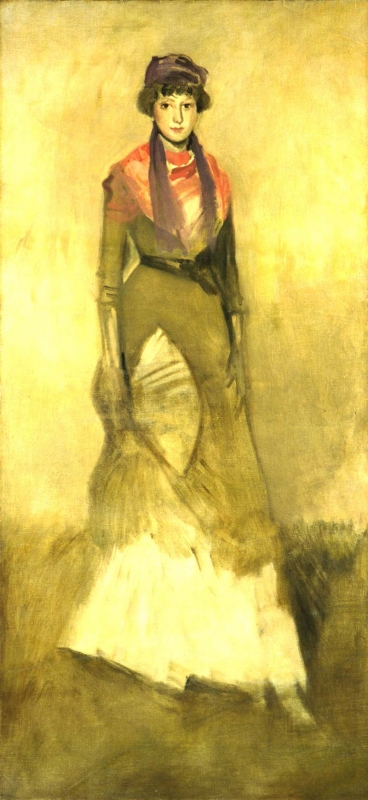Home > Catalogue > Browse > Harmony in Fawn Colour and Purple: Portrait of Miss Milly Finch << >>
Technique
The canvas is a coarse, heavy-weight plain tabby weave, with conspicuous slubs in the weave providing a varied texture overall. It appears to have been prepared with two ground layers, of pale and dark grey. The canvas has the stamp of Blanchet, 20 rue Saint-Benoît, Paris, on the verso, although the model was almost certainly painted in London.
The paint in the background and on the dress is thinly applied with wide brushes, in contrast to the smaller, more opaque dabs of colour in the face, scarf and headdress. There are some scumbled and scraped areas alongside more thinly applied paint. Her head has been rubbed down, and then repainted with a few rough strokes of the brush. Her eyes were painted with very thin paint. Her right hand and part of the fan have been rubbed down.
Edith Emma Marzetti (1865-1924) described Whistler's painting method in the early 1880s, in relation to another full length portrait, Scherzo in Blue: The Blue Girl [YMSM 226]:
'Whistler's mode of painting was most comical: he stood yards away from the picture with his brush, and would move it as though he were painting; he would then take a hop, skip and jump across the room, and put a dab of paint on the canvas; he also used to wet his finger, and gently rub portions of his picture.' 1
Conservation History
It is just possible that a portrait of another sitter was begun on the canvas by Whistler before his bankruptcy in 1879, destroyed by him then, and the canvas re-acquired later and re-used.
The canvas has apparently been folded, and there are several horizontal creases and ridged lines across it, some of which have been retouched. It has been relined at some time, possibly to repair the resulting fracturing and damage to the paint. The lining canvas is of a lighter weight, and finer weave than the original. There is some retouching, which is concealed by the slightly discoloured and streaky varnish. It is in generally sound condition. 2
Frame
204.2 x 101.7 x 6.2 cm. The stamp of Emile Blanchet (1852-1931) is on the verso of the stretcher: 'BLANCHET / 20 / RUE SAINT BENOIT / PARIS'
Last updated: 19th October 2020 by Margaret






